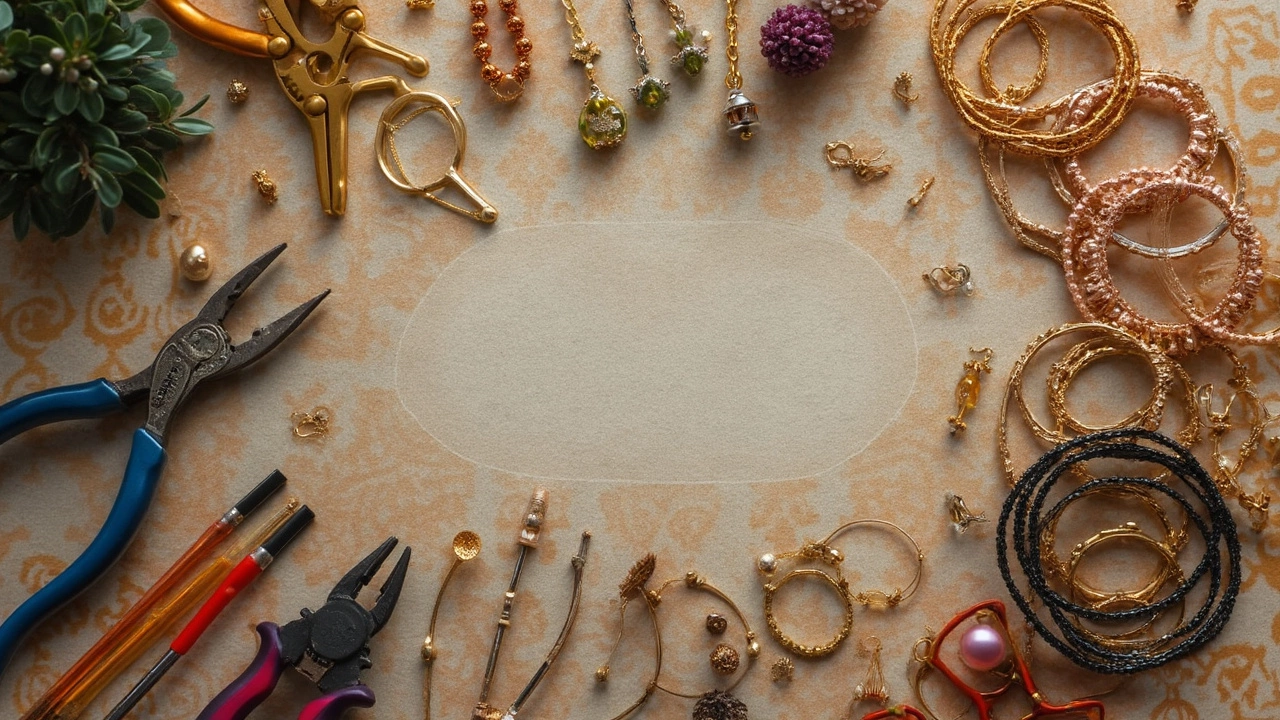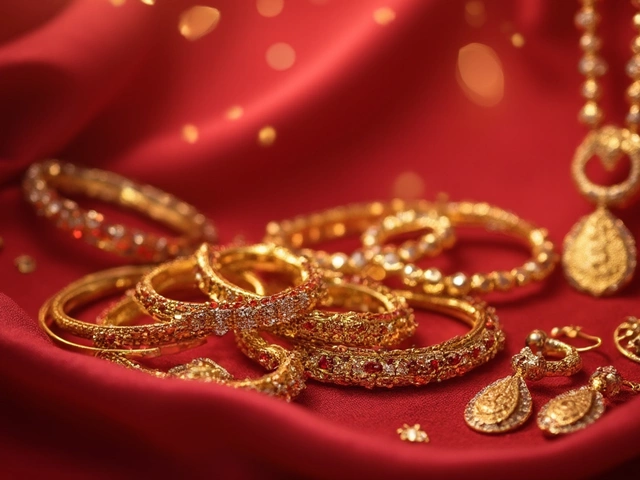If you're eyeing those jewelry making kits and thinking, "Can I actually make money from this?"—you're not alone. Tons of people want that quick win: craft some cool pieces, toss them online, and see them fly off the shelf. But the truth? Not every style sells like hotcakes. Some designs just click with buyers, while others collect dust in your drawer (trust me, I've been there—Aryan's bead experiments are legendary, but not everything is a winner!).
The trick is figuring out what people actually want to wear. Not just what's fun to make or looks good in a photo, but what buyers pull the trigger on. Think simple, wearable, everyday stuff—because that's what moves the fastest. People love jewelry that matches a bunch of outfits, isn't fussy, and can be worn on repeat. You want to make pieces that solve that little wardrobe puzzle for someone with zero effort.
Don't worry. You don't need fancy tools or crazy skills to get started. With a decent jewelry kit and some basics under your belt, you can make styles that practically sell themselves. And once you know what shoppers can't resist, you can actually enjoy crafting—without the stress of wondering if anyone wants your stuff. Let's figure out which pieces give you the most bang for your buck.
- Why Certain Jewelry Sells Easily
- Proven Winners: The Bestsellers
- Choosing Kits That Set You Up for Sales
- Tips for Fast-Selling Results
Why Certain Jewelry Sells Easily
Ever notice how simple stud earrings or a basic chain bracelet never seem to go out of style? There's a reason for that: most people reach for jewelry they can wear daily, that goes with lots of outfits, and that doesn't cost a fortune. Buyers look for comfort, easy-to-match colors, and pieces that won't break in a week. That means classic, no-fuss styles tend to sell out faster than wild or super-trendy ones.
According to shops on platforms like Etsy, small dainty jewelry pieces are the bestsellers. Think little pendants, minimalist hoops, stackable rings, and beaded bracelets. These pieces are lightweight, simple to make if you’re using jewelry making kits, and buyers aren’t afraid to buy more than one because they're affordable. If something gets lost, it’s no big deal to replace, so people buy backups or try new colors.
Trends matter a lot too—but don’t bet everything on a passing fad. Custom name necklaces, birthstone charms, and friendship bracelets get snatched up, especially when you let buyers pick their own colors or letters. But even then, it’s the wearable shapes and low price that keep them moving. Bulky, heavy, or ultracrazy designs usually take longer to sell, unless you find that one obsessed buyer.
Finally, materials are a big deal. Hypoallergenic metals, glass beads, and things that “look expensive” (like gold or silver plated chains) sell better than plastic or questionable metals. People read product descriptions! If you’re selling to teens, playful colors and charms work. For adults or gift shoppers, it’s all about subtle and classic.
Proven Winners: The Bestsellers
Some jewelry styles just sell faster than others, especially when you're working with jewelry making kits. If you check out top sellers on Etsy, Amazon Handmade, or even local pop-ups, you'll see a pattern: buyers love simple, ready-to-wear pieces that mix easily with their daily looks.
Here are the hero products that fly off the shelves, whether you’re a beginner or hoping to step up your side hustle:
- Beaded Bracelets: Especially those with personalized letter beads, stretch cord, or birthstones. These are huge with both teens and adults because they’re fun, stackable, and feel custom.
- Simple Stud Earrings: Tiny pearls, clay shapes, or glass stones. They don’t go out of style and you can make dozens in an afternoon with the right kit.
- Minimalist Necklaces: Think dainty chains with small pendants or bar charms. People look for pieces they can layer or keep on all week without thinking about it.
- Charm Keychains and Bag Charms: Not technically traditional jewelry, but they use the same tools. Moms and kids love adding flair to bags and keys, and they’re usually easy impulse buys.
- Anklets: Especially in summer, simple anklets with beads or delicate chains sell like crazy—people want something cute but not over-the-top.
The biggest sellers share a couple of things: they’re light, easy to ship, and don’t require heavy custom sizing. Buyers skip anything that looks hard to wear or style. If you’re making for men, leather cord bracelets and basic metal necklaces always get a quick look—think no-fuss, rugged styles.
Insider tip—seasonal trends totally matter. For example, shells and seed beads spike around spring and summer. In winter, gold or silver tones, simple pearls, and anything “gifting-ready” get attention. It pays to keep an eye on what’s blowing up on platforms like TikTok, because micro-trends can go viral overnight (and if your kit has the right supplies, you can jump in fast).
The main takeaway? Start with the classics, then add your own twist once you get the hang of what’s selling. You don’t need to reinvent the wheel—it’s about easy-to-love designs, not making something super complicated from the start.

Choosing Kits That Set You Up for Sales
If you want your jewelry to actually sell, picking the right kit is half the battle. Not every kit is a good fit for reselling—some are just for fun, full of beads and charms nobody really wears. Instead, look for kits that focus on top-selling styles and offer enough materials to make several pieces, because the more you make, the more you can sell.
The first thing to check is whether the kit helps you make jewelry that's already proving popular. For example, minimalist necklaces, stacking bracelets, and hypoallergenic earrings have seen crazy demand lately—Etsy even reported that "minimalist jewelry" searches shot up by 50% last year. If a kit helps you make those? You're on the right track.
Quality makes a real difference too. Buyers don’t want a necklace that snaps after two tries. Focus on kits with real metal components (like stainless steel, sterling silver, or gold-plated findings). These don’t tarnish fast, and people are more likely to buy and keep coming back for more.
- Look for kits with clear labels on metal types and allergy-safe options.
- Avoid kits overloaded with dated, neon, or cartoonish beads. Trendy is good, kid-tacky isn’t (unless you’re selling to kids—for moms like me, themed friendship bracelet kits work in school fundraisers, but not much elsewhere).
- Check if the kit comes with basic tools like pliers, crimpers, and solid clasps. Buying these separately gets annoying and expensive.
- Choose kits that include simple instructions (video guides = gold, by the way).
Here's a quick look at the top seller types you can make from many popular jewelry making kits:
| Jewelry Type | Average Sale Price (US$) | Typical Kit Amount | Buyer Demand |
|---|---|---|---|
| Stackable Bracelets | 10-25 | 20-30 | High |
| Minimalist Necklaces | 15-35 | 10-15 | Very High |
| Simple Stud Earrings | 7-20 | 25-40 pairs | High |
If you’re stuck, check product reviews before buying anything. Sellers often mention if their kits resulted in quick sales, and you’ll spot patterns on which ones are worth your time. A beginner-level kit with good reviews on Amazon or Etsy usually means you're not the only one hoping to turn a hobby into extra cash.
Tips for Fast-Selling Results
So you’ve finished your latest batch and you’re ready to cash in. The usual advice—“post on Instagram” or “tell your friends”—only gets you so far. Here’s what actually makes a difference when you want your pieces to move fast.
- Jewelry making kits with trendy, universal designs get more attention. Think: minimalist bracelets, gold-plated chains, and stackable rings. People love what’s easy to layer and mix.
- Good lighting in your product photos makes a night and day difference. Stats from Etsy say listings with crisp, true-to-life photos are 60% more likely to get clicked.
- Keep your prices realistic. Most first-time buyers try pieces under $30. Don’t go fancy with packaging at the start—simple works, and keeps costs low.
- List your jewelry on more than one platform. Quick example: sellers who use both Etsy and Facebook Marketplace sell about 30% more, on average, than those who stick to one spot.
- Offer bundles. Three pairs of simple earrings for one set price almost always outsell one expensive item. Bundles feel like better value to shoppers.
- Respond fast to questions. According to Shopify, sellers who reply within an hour see a 27% jump in conversions. Buyers want answers now, not later.
- Watch trends but don’t chase every fad. Birthstone necklaces and initial pendants never go out of style. You’ll get more repeat buyers with these timeless hits.
Here’s a quick data table so you can see what’s working in real numbers:
| Jewelry Type | Average Days to Sell | Top Price Range (USD) |
|---|---|---|
| Minimalist Stud Earrings | 6 | $12–$20 |
| Stackable Rings | 8 | $10–$18 |
| Charm Bracelets | 10 | $15–$30 |
| Birthstone Necklaces | 5 | $18–$32 |
Try to put yourself in the buyer’s shoes. Would you wear it every day? Is it affordable? Does it look polished in the picture? Nail those three, and you’re set for faster sales than most hobby sellers. It’s about working smart, not hard.



